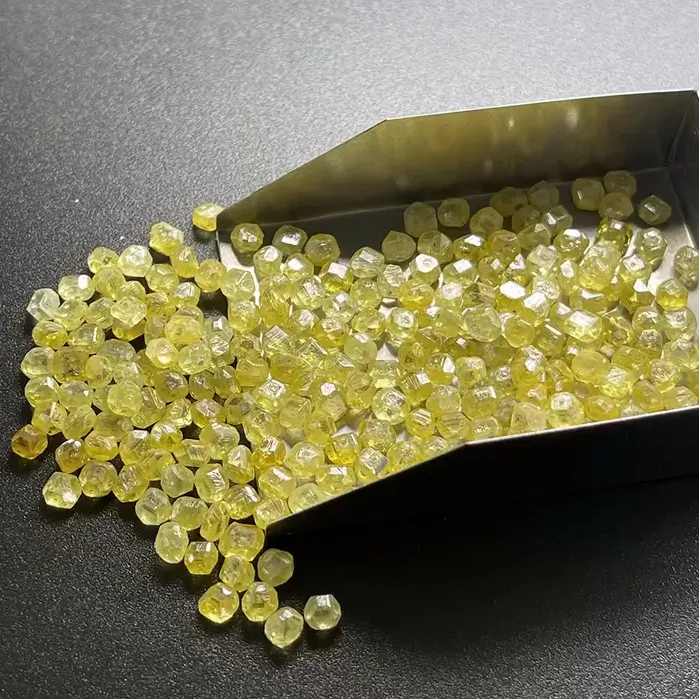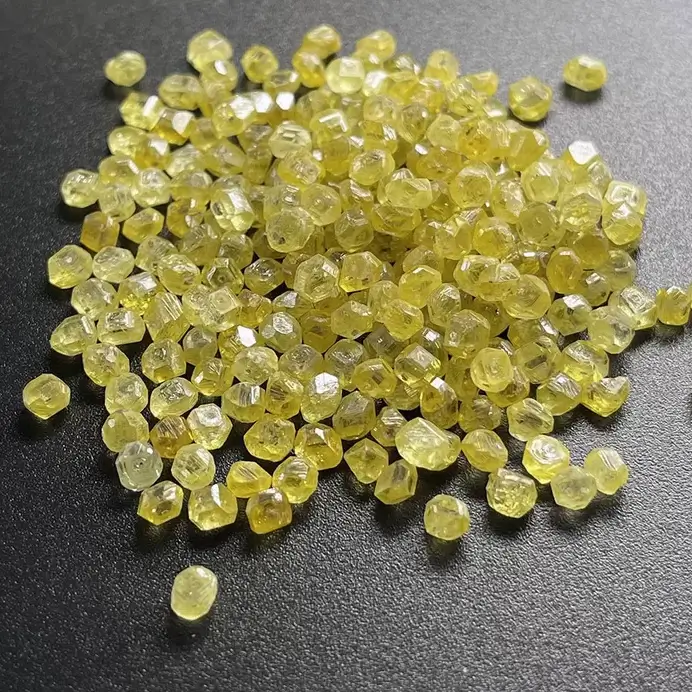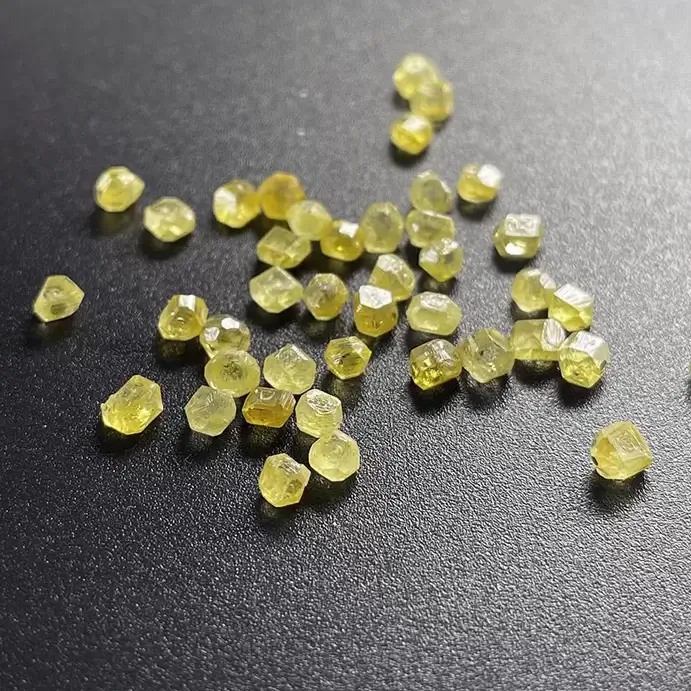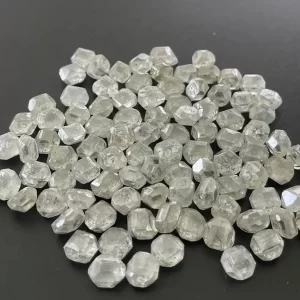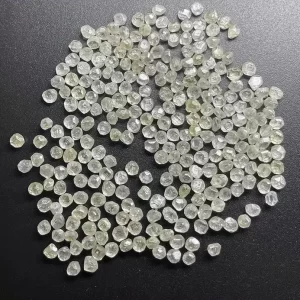50 Points Intense Yellow Lab Grown Colored Diamonds 5.0mm To 15.0mm
Intense Yellow Vs Si Clarity Lab Grown Colored Diamonds For Cutting Lab Grown Fancy Color Diamonds
Lab Grown Colored Diamonds Description
What is lab grown diamonds?
Lab grown diamonds are made from crystalline carbon in the laboratory, and they are the same in physical and chemical composition, which means that they are equivalent to diamonds mined in any way.
Are the diamonds made in the laboratory real diamonds?
The optical, physical and chemical composition of natural and laboratory diamonds are the same. The difference between laboratory made diamonds and mined diamonds is that one is made in the laboratory and the other is mined naturally.
Lab Grown Diamonds, known as synthetic diamonds. At present, there are two main methods to make lab grown diamonds: high temperature and high pressure method and chemical vapor deposition method. These two kinds of diamond production methods are different, the products are the same, named lab grown diamond.
Intense Yellow Lab Grown Colored Diamonds
Intense yellow diamonds are more rare than light yellow diamonds, which are cheaper and less expensive. Lab-grown yellow diamonds, however, are more desirable than light yellow diamonds. These diamonds can be either canary yellow or light yellow, a combination that is rare but highly desired. Read on to learn more about both types of yellow diamonds and which one is right for you.
Canary yellow diamonds
Fancy colored diamonds are often referred to as canary yellow, and they can be a unique option if you’re looking for something unique. While naturally mined fancy colored diamonds have inherent limitations due to the processes of nature, lab grown diamonds can be a more vibrant shade of yellow and are significantly cheaper than natural diamonds. Below is a look at the most common types of fancy colored diamonds and how lab grown diamonds differ from natural diamonds.
Lab grown diamonds come in many different shades of yellow, including a rich, deep shade of canary yellow. The amount of nitrogen that is added to the diamond during the growth process is responsible for the color change. The more nitrogen added, the deeper the shade. While these diamonds are very common, the deeper varieties are generally more sought after. While faint yellow diamonds are not uncommon, they are often considered less desirable than deeper varieties.
The Gemesis brand, which is the first company to sell canary yellow lab grown diamonds, is a leading diamond supplier in the Northeast. It was recently renamed Pure Grown Diamonds. The company’s goal is to replicate the brilliance of the sun, so the diamonds are just as beautiful as natural ones. Despite the difference in price, Mayfair Jewelers is proud to offer these diamonds at a fraction of the cost of comparable natural diamonds.
While canary yellow lab grown diamonds may be a more affordable alternative to natural diamonds, they have the same chemical composition as natural diamonds. They also are less expensive, weighing in at around 50% of the original diamond. The difference between a naturally mined yellow diamond and a lab grown one is the degree of yellow intensity. Depending on the intensity of yellow, you can expect to pay $4000 or less for a one-carat canary diamond.
The most desirable Canary yellow diamond is one that has a high value. Zimmi Diamonds, which are also produced in Sierra Leone, are of similar quality. However, Zimmi Diamonds are more expensive than Canary Yellow Diamonds. One such Zimmi Diamond is a 0.76 carat SI1 clarity Heart Shape. For those interested in a more affordable alternative, Leibish & Co offers a 0.76 carat Zimmi Diamond.
While it’s true that the color of a yellow diamond may not be as bright as a white one, the diamond is not without its appeal. A round cut won’t sparkle well in this type of ring. Another option is a radiant cut. Canary yellow lab grown diamond will look elegant when set in a yellow gold bezel or tub. They are also available in white gold or rose gold. Whether you want a classic look for your engagement ring or a more modern version for your special lady, lab created fancy yellow diamonds are a great alternative. In addition to looking and gleaming like a real diamond, they are also rated in the same manner.
Fancy yellow lab-grown diamonds are generally darker than their counterparts, and they are often paired with white, light-colored or colorless diamonds. They are an excellent choice for extreme fashion jewelry and look particularly great in stud earrings. You can use these yellow diamonds to create a truly unique and exotic look for your jewelry. In addition to looking exotic, they are also a great choice for yellow gold jewelry.
Canary yellow diamonds are the rarest type of fancy yellow diamond. They are often termed canary yellow and can command the highest price. The color of these diamonds is derived from the nitrogen found in their composition. As the nitrogen in diamonds absorbs blue light, they turn yellow. The amount of nitrogen is different depending on the color of a diamond, so a canary yellow lab-grown diamond may be more expensive than a normal yellow diamond.
GIA has graded nearly every major fancy color diamond in the world. Since lab-created diamonds do not have an inherent value, GIA reports are the most reliable sources for pricing them. Fancy yellow lab-grown diamonds can be eye-clean or appear dark, and you can find them in many settings. You can even find one that is eye-clean with the desired color, but be wary of the fact that many lab-grown diamonds can be overly saturated and look even darker when set in a gold setting.
Light yellow diamonds
Despite their vivid yellow color, light yellow lab grown diamonds are still far less rare than natural ones. They take billions of years to form in nature, whereas lab-grown diamonds are created in just a few weeks. In addition, natural diamonds with vivid yellow hues are even rarer and more expensive. Fortunately, light yellow lab grown diamonds have the same brilliance and appeal as natural diamonds, but are created without any blood or crime against humanity.
Although rarer than naturally occurring yellow diamonds, lab-grown diamonds can match any color in your ring. They are much easier to find in other cuts, like round brilliants. Light yellow diamonds tend to appear slightly darker when set in jewelry. Before the development of lab-grown diamonds, fancy colored diamonds were only available in very rare shapes, and were regarded as a luxury item. However, the unique beauty and rarity of light yellow lab grown diamonds has prompted more modern couples to consider buying them as a gift for their significant others.
Although light yellow diamonds are much rarer, lab-grown ones are not as expensive. They exhibit the same optical properties as natural diamonds, but are not mined. This makes them more environmentally responsible and ethical than natural diamonds. Ideal Make diamonds are especially valuable, as they have the best brilliance and shine and emit the most light. These qualities make them highly sought-after among buyers. These diamonds are also available at lower prices than natural ones.
Light yellow lab grown diamonds are not as rare as natural diamonds, but can be just as colorful as them. The difference is in the amount of nitrogen introduced during the growing process. A higher level of nitrogen means a deeper shade of yellow. Naturally occurring diamonds take billions of years to grow, while a lab-grown fancy yellow diamond can be created in a matter of weeks. As a result, light yellow diamonds are more expensive than natural diamonds.
These diamonds have the same cut and carat as natural diamonds, but their color is softer and more saturated in lab-grown ones. In contrast, a vivid canary yellow diamond is brighter and has more appeal. Light yellow lab grown diamonds are less expensive than natural diamonds, but their price decreases quickly once they have been purchased. Light yellow lab grown diamonds are also more prone to being dark in their settings, so be sure to compare price when shopping.
Another way to determine the cost of light yellow lab-grown diamonds is by considering the shape and size of the diamond. While a round diamond is typically more affordable than a square diamond, elongated shapes offer lower yields and should be avoided. For this reason, the most expensive diamonds are often made of round or pear-shaped diamonds. The best way to determine whether light yellow lab grown diamonds are cheaper than natural diamonds is to visit a jeweler and discuss your options.
While yellow lab-grown diamonds have higher carat weight than natural stones, the price of a light-yellow stone depends on its hue. As a result, a light-yellow diamond may be worth two to three times as much as a blue or green diamond of the same carat weight. If you’re interested in a light-yellow diamond, don’t forget to consider the quality of its cut and clarity.
Fancy-colored lab-grown diamonds are a popular alternative to traditional diamonds. These diamonds are available in a wide range of colors, from orange to pink, and can be set in traditional solitaire settings. A light-yellow diamond with a slightly yellow hue is also beautiful and durable. They’re often sold as fancy diamonds in addition to traditional solitaire settings. However, it is important to note that light yellow lab-grown diamonds may not be as sparkly as their natural counterparts.
Fancy-yellow lab-grown diamonds come in a variety of shades. The intensity of their yellows can vary from the palest to the most intense. However, the diamond color is recognizable, and the color is graded similarly to real diamonds. A yellow diamond is considered a fancy-yellow diamond if it sparkles when viewed under the same lighting conditions as a white diamond.
Light yellow lab-grown diamonds
If you’re in the market for a fancy ring, you may want to consider a light yellow lab-grown diamond. These diamonds are available in VS2 clarity and Super Ideal cut. They come with an IGI report. Although they are not exactly as bright as natural diamonds, lab-grown diamonds have the same optical properties. Plus, because they are created in a laboratory, there is no mining involved, making them a more ethical and environmentally friendly option. These diamonds are also affordable, coming in at just 0.40 carats.
Although light yellow lab-grown diamonds are harder to come by, they are much less expensive and more popular than other options. This makes them an excellent choice for those looking for a diamond at a more affordable price. However, it is important to note that these diamonds are not as rare as natural diamonds, so you may want to consider a more expensive alternative instead. This option is not only less expensive, but it can be more personal and unique than a natural diamond.
Fancy yellow diamonds are considered rarer than their more common counterparts, and are much more difficult to find. This is mainly due to the color of these diamonds, which hide flaws in the diamond. Additionally, if you are looking for a yellow diamond, it’s best to choose a fancy-cut diamond rather than a round one. Choosing the right cut and clarity is important as well, but you should also pay attention to the diamond’s shape. The cut is the most important factor in buying a fancy yellow diamond.
While natural yellow diamonds cost around $700 per carat, lab-grown diamonds can save as much as 47% or more in expenses. In addition, lab-grown diamonds don’t cause any damage to the environment and can be more affordable than natural ones. However, they can also be darker than natural diamonds, so be sure to shop around for the perfect light yellow diamond for your next ring. You might be surprised to discover that lab-grown diamonds can be as beautiful as their natural counterparts.
Despite the fact that lab-grown diamonds don’t have the exact characteristics of natural diamonds, they are still real diamonds and are graded as such. Their different shades are caused by the addition of nitrogen during the growing process, and the higher the nitrogen content, the deeper the shade of yellow the diamond. Light yellow diamonds are common and cheap, but you can expect a higher price for a fancy-colored one.
Light yellow lab-grown diamonds have an attractive look that can be used for an engagement ring. While the diamonds themselves are less expensive than natural ones, the color of the setting can influence how they look. A yellow-gold setting can make the diamond look darker, so be sure to choose an engagement ring that is complemented by a basket of yellow gold. You can choose to set a diamond with a basket of yellow gold to give it a bright and modern appearance.
Grades of lab-grown fancy colored diamonds
VS clarity is the most common grade for lab-grown fancy yellow diamonds. This grade refers to the absence of inclusions within the stone, which are visible under a 10X magnification. Lab-grown diamonds are often created through a process called chemical vapor deposition and can also have black spots or graphite inclusions. Inclusions can affect the free passage of light within a diamond. The clarity of diamonds is determined by examining each diamond under a 10X magnification. The number and placement of inclusions are factors in determining the clarity grade.
Color is another important criterion when buying a fancy yellow diamond. Unlike traditional diamonds, lab-grown yellow diamonds are graded differently than regular ones. While regular diamonds are graded on a D to Z scale, fancy yellow diamonds pass close to Z. The intensity of the color is then measured and given a grade. This is the same as for other lab-grown diamonds.
A laboratory-grown fancy yellow diamond may be labeled as natural or synthetic. Its color is caused by nitrogen, which influences the yellow hue. The process produces a diamond with a much faster growth time than its natural counterpart. The growth time of a lab-grown yellow diamond is about one week. Although natural yellow diamonds may be rare, lab-grown ones are popular among consumers. They are unique and cost less.
The GIA has graded nearly every significant fancy colored diamond in the market. Its report of a diamond’s color is a trusted benchmark when it comes to pricing. Fancy deep yellow diamonds are full yellow, and may have a greenish or orange undertone. If you’re looking for an eye-clean yellow diamond, it’s likely that you’ll find one that has the exact color you’re seeking.
Because yellow diamonds are difficult to find in round cuts, they are best suited for other types of jewelry. While light yellow diamonds are not desirable, deep yellow diamonds and bright white diamonds are extremely popular. Fancy colored diamonds are best exhibited in non-round cuts. A higher color-intensity diamond will cost more than one with a lighter hue. If you’re unsure about which grade to choose, consider purchasing a yellow diamond and seeing how it turns out.
While mined vivid yellow diamonds are highly prized and rare, lab-grown fancy yellow diamonds are affordable and available on demand. In fact, lab-grown fancy yellow diamonds are often less expensive than natural ones, so you’ll be surprised by the savings you’ll make. But remember, they still have a yellow color – and this means they’re a great value! But don’t let that fool you – the color grade of your diamond will depend on the exact amount of nitrogen introduced into the growth process.
While GIA has decided to certify lab-grown diamonds, the grading reports are not as precise as those for natural ones. GIA’s grading report is a valuable tool to help you choose the right diamond for your budget. A certified diamond is more likely to be durable and have less color variation than a synthetic one. It is important to remember that GIA has no control over whether or not a given lab-grown fancy yellow diamond is certified by the GIA.
50 Points Intense Yellow Lab Grown Colored Diamonds 5.0mm To 15.0mm
